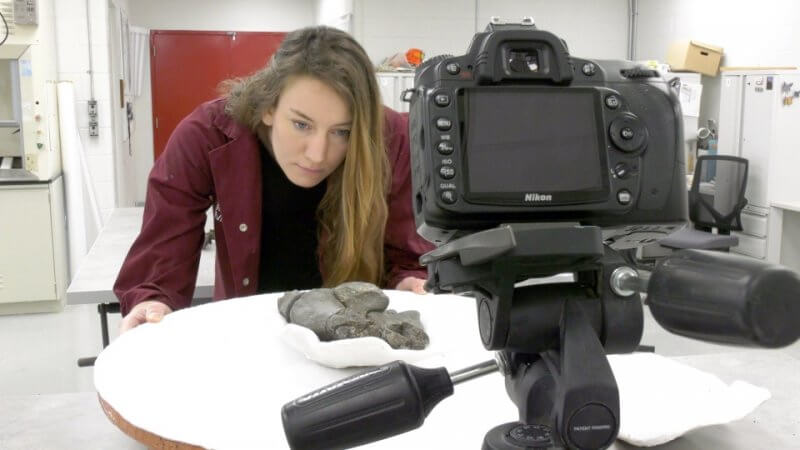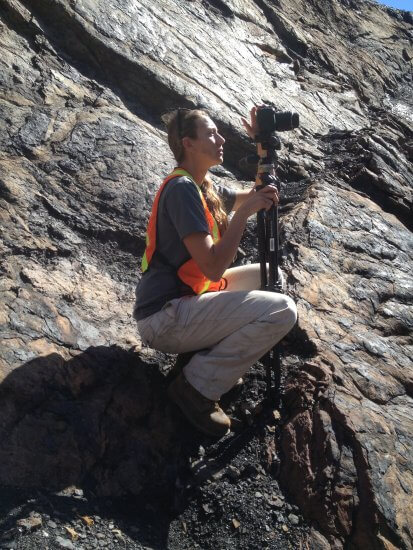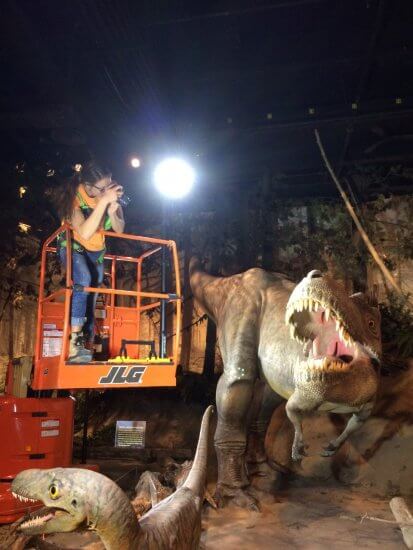Buildings or bones: Heritage Resources Management courses widely applicable
When you think of the words “heritage resources,” it’s not likely that dinosaur bones are the first thing that come to mind.

But Amy Kowalchuk, currently working on her Graduate Diploma in Heritage Resources Management from the Faculty of Humanities & Social Sciences at Athabasca University (AU), is already putting her education to use in her role as lab technician with the Royal Tyrrell Museum, based in Drumheller, Alta.
“I photograph and digitize the specimens, but also fossil localities and sites, and also larger specimens in the field that are too large to collect,” she said. “I’ll photograph them and make digital models of them so they can still be physically studied, even though we can’t have them in the museum.”
She got a job with the museum shortly after finishing an anthropology degree in 2015. At first she was mostly preparing fossils, but it wasn’t long before she had moved into the more technical role. She continues her job as an intern within the Historical Resources Intern Program (HRIP), an innovative partnership between AU and the Government of Alberta.
But for much of what Kowalchuk was doing, she was essentially self-taught and learning on the job as she went. She worked to establish her own procedures in her role without a specific educational background in that type of work.
Historical Resources Intern Program

That began to change when she was accepted to HRIP, through which she has connected with experts and colleagues working in other sites and museums.
“Having a cohort of fellow students in my online courses who may work in different sectors of heritage has helped enrich my learning and broaden my views,” she said. “Especially when working in a somewhat isolated institution, I think it’s really important to maintain those relationships across the division.”
Learning from experts, like Dr. Mario Santana Quintero during an AU course last spring and summer on Documentation and Condition Assessment (HERM 671), has been invaluable in helping Kowalchuk to refine her processes and gain a greater understanding of the kind of work she’s doing and how best to do it.
“It helped shadowing someone already working in the field of heritage but using similar techniques, and seeing how it can be applied much more broadly while also gaining new ideas of what we could be doing with it,” she said.
For example, Kowalchuk has adjusted the types of settings she uses on her camera when taking the initial pictures for use in 3-D modeling and has had her eyes opened to the potential of introducing newer technologies like drones and 360-degree lenses.
“A lot of the different components we went through in this course, I realized would be extremely applicable if we used them at the museum in a different context,” she said.
Further to refining her technical skills in doing this sort of work, she also has found other courses with the diploma program to help broaden and enhance her perspective on her role, and that of the museum as a whole.
Heritage Resources Management program

AU’s Heritage Resources Management courses cover a broad range of topics from built heritage to museum collection, management of sacred places and landscapes, interpretive programming, risk management, heritage collection, preventive conservation and architectural conservation.
Kowalchuk said Heritage Policy in Canada (HERM 327), for example, applies to all types heritage resources including paleontology. And even a course on Architectural Conservation (HERM 673) taught her techniques she was able to apply more broadly to support the work she’s doing with dinosaur fossils.
And, given her full-time job that involves spending a lot of time working from the field, she said advancing her education wouldn’t have been possible without the flexibility AU offers.
“What’s been really, really, great, is even in the summer when I’m away a lot doing fieldwork, I’ve still been able to keep up on coursework while being remote, which is really novel to me,” she said.
And as Kowalchuk has been able to post to class forums from base camp in Dinosaur Provincial Park after a long day of field work—including posting photos from that day’s work—her classmates may also benefit from that flexibility.
She added she would recommend program to anyone working in heritage-related fields, as it’s had such a significant impact on her own work—not just in term of performing day-to-day functions, but also in terms of gaining a broader understanding of the impact her work can have on the public by providing access to specimens and learning opportunities that might not otherwise be available to them.
“It’s been invaluable to me to actually understand on a wider scope the role of a museum, how we do things and why we do things the way we do them, and how our policy and mandate actually inform our actions,” she said.
To learn more about the Graduate Diploma and Undergraduate Certificate in Heritage Resources Management, please visit the program website.